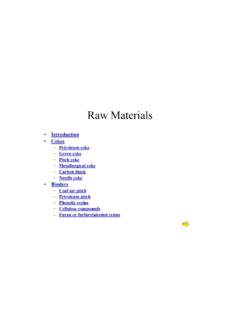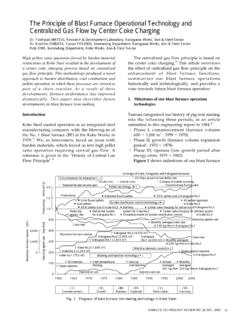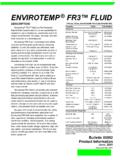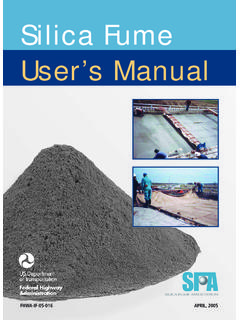Transcription of ferrochromium – Pretreatment for smeltinG
1 The Twelfth International Ferroalloys CongressSustainable FutureJune 6 9, 2010 Helsinki, Finland275ferrochromium Pretreatment for smeltinGThe Twelfth International Ferroalloys CongressSustainable FutureJune 6 9, 2010 Helsinki, Process of Making Sintered Pellets As explained in Figure 1 below, the chrome ores received from the mines are wet ground in grinding mills, with addition of little coke fines. Then the slurry is sent to the filtering unit for dewatering and the filter cake is sent to pelletiser unit after mixing required quantity of bentonite. The green pellets from the pelletiser are then fired in belt sintering machine for sintering at 1300-1400oC temperature. After sintering the green pellets get stronger and become ready for charging into submerged arc furnace as the feed[4]. Coke Cr-fines from Mines Wet Grinding Filtering to reduce moistureProduct: Sintered Pellet Sintering at 1400oC Pelletizing to form green briquettes Mixing with bentoniteFigure 1: Flow chart for making sintered pellet Process of Briquetting As explained in Figure 2 below, the chrome ore fines received from mines are first dried in dryer.
2 The dry ore is mixed with bentonite, hydrated lime and molasses, and the green mix is then fed to the briquetting presses. The presses compact the mixture at high pressure to form green briquettes. The green briquettes are stored in the storage yard for curing. After curing at ambient temperature for 24-48 hrs, the briquettes become stronger and are fed into Submerged Arc Furnaces. Briquetting DryingProduct-Green Briquettes Mixing with hydrated lime, bentonite & molasses Chromite fines from Mines Product: Cured Briquettes Figure 2: Flow chart for making briquettes 3 PLANT FACILITIES The briquetting plant at Richards Bay is a completely automated plant. The major facilities of the briquetting plant are given below. 2 x 33 t/h Briquetting Presses 2 x 30 t/h Rotary Dryer 2 Nos.
3 High Energy Intensive Mixers 1 x 3000 Molasses Storage Tank Molasses preparation and dosing system Conveyors, bucket elevators, loss-in-weigh feeders 120 t/h capacity Stacker Two Submerged Arc Furnaces of 38 MVA capacity each are used for smeltinG . ferrochromium Pretreatment for smeltinGThe Twelfth International Ferroalloys CongressSustainable FutureJune 6 9, 2010 Helsinki, Details of the Briquetting Presses Technical data Roller diameter (nominal diameter) 750 mm Working width of pressing tool 310 mm Type of pressing tool Strip segments Total weight of machine 19300 kg Operating data Product capacity nominal t/h Speed nominal 16 rpm Min., variable 10 rpm Max.
4 20 rpm Drive rating nominal 150 kW At n=max 182 kW Specific pressing force nominal 40 kN/cm Max 52 kN/cm Total pressing force nominal 1240 kN Max. 1508 kN 4 RECIPE FOR BRIQUETTES Briquettes need to have high hot strength to combat disintegration under load and high temperature conditions prevailing inside the furnace. Besides hydrated lime and molasses conventionally used for chrome ore briquettes, TSKZN used bentonite as the additional binder to promote hot strength as required for closed SAFs. All the binders, namely, molasses, hydrated lime and bentonite are sourced from local South African suppliers 5 SIZE OF THE BRIQUETTES Briquette volume (nominal volume) 27cm3 Briquette size mm x mm x mm Specific weight of briquettes gm/cm3 (approx) 6 COMPARATIVE FEATURES OF BRIQUETTING AND SINTERING Features of the processes of briquetting and sintering are presented in Table 1 below.
5 ferrochromium Pretreatment for smeltinGThe Twelfth International Ferroalloys CongressSustainable FutureJune 6 9, 2010 Helsinki, Finland278 Table 1: Comparison of various features of briquetting and sintering processes Sl. No. Parameters Sintering (Outokumpu Process, Finland) Briquetting (with Binders tried by TSKZN) 1. Capital Cost Very high Low 2. Design and Engineering Fairly complicated Very simple, involves normal material handling modes 3. Intellectual Property Rights (IPR) Applicable in favour of Outokumpu Covered by IPR by Tata Steel 4. Royalty Fees Applicable Applicable in favour of Tata Steel 5. Supervision cost during erection High Moderate 6. Ramp-up period 75% in 6 months, 90% in 12 months 50% in 1st month, 75% in 3 months, 90% in 12 months. 7. Use of CO rich Furnace off-gas for process About 40% of the export gas needs to be used for sintering of the green pellets Briquetting being a room temperature process, does not need to use the CO rich furnace off-gas for any process needs.
6 However, heat-hardening remains a possibility, but that being a lower temperature process, will consume lower amount of gas 8. Issue of generation of suspected Carcinogenic Cr +6 Sintering takes place at a temperature as high as 1400oC, leading to generation of suspected Carcinogenic Cr +6 through oxidation Briquetting being a room temperature process, there is absolutely no question of generation of Carcinogenic Cr +6 through oxidation. This process, therefore, is much more friendly to the environment. 9. Potential of Co-generation of Power As a substantial portion of CO rich furnace gas is to be used for sintering of pellets, the quantum of surplus gas is normally not adequate to justify a captive power plant economically. Availability of significantly high quantity of surplus CO rich furnace gas ensures co-generation of electrical power very efficiently through the use of modern power plant equipment.
7 This also attracts Carbon Credit additionally, which is commercially attractive and satisfies the Corporate commitment to a cleaner environment. 10. Plant availability 98% 97% 11. Specific power consumption low marginally higher 12. Cost of production High Low 7 STEPS TAKEN ON PROCESS DEVELOPMENT AND ENGINEERING The following steps were taken by TSKZN for development of the briquetting process and design, engineering, erection and commissioning of the briquetting plant. The activities are listed in chronological order. 1st briquetting test work was conducted in the pilot plant in Germany with Indian Ore in April 2004. The briquettes made from Indian ore, were charged into the 30 MVA Submerged Arc Furnace of Tata Steel s own Ferro-Chrome Plant in Bamnipal to the extent of 70% of the furnace feed and the trial continued for 17 days.
8 Among the different types of Submerged Arc Furnaces, Closed Top Submerged Arc Furnace is the most environmentally friendly and was the selection of TSKZN for Richards Bay plant. But briquettes in high proportion were never tried in Closed Top Submerged Arc Furnace earlier. The success of Bamnipal trial paved the way for TSKZN to finalize the selection of briquetting in Closed Top Submerged Arc Furnace. ferrochromium Pretreatment for smeltinGThe Twelfth International Ferroalloys CongressSustainable FutureJune 6 9, 2010 Helsinki, Finland279 Based on the above two trial data available, basic engineering, designing of the briquette plant started from end of 2006. 2nd briquetting test work was conducted in the same pilot plant in May 2007 to test the suitability of South African ore for briquetting.
9 Based on the trial results certain modifications are done in the plant design that had already started. Construction of the briquetting plant started from the month of April 2007 and completed by end September 2008. South African operators were trained in briquette plant operation because briquetting was an unknown technology in South Africa. The commissioning activities of the plant with South African ore started from the month of October 2008 and continued for one month. By the end of the month the first batch of briquettes were made from South African chrome ore concentrate. The quality of the briquettes was even better than the trial results. After that, the challenge was to increase the production and reach up to the rated capacity and subsequently feed the briquettes to the Submerged Arc Furnaces.
10 The production and availability of briquetting plant improved over the months November 2008 to March 2009. Subsequently feeding of briquettes into the furnaces started from the month of November 2008, with an effort to increase it as much as possible, keeping the other parameters undisturbed. Proportion of briquettes in the furnace charge has been reached up to 40% of total chromite feed. 8 IMPORTANT MILESTONES First briquette production with molasses and hydrated lime: 26th October 2008 Declared Commissioning of Briquetting Plant: 27th October 2008 First briquette charged into smeltinG furnace: 21st November 2008 First briquette production with bentonite as the additional binder: 3rd December 2008 First Despatch of product Charge Chrome using Briquettes: Huangpu Port, China for Lianzhong Stainless Steel Corporation All the above developments related with briquetting have taken place for the first time in the world.










